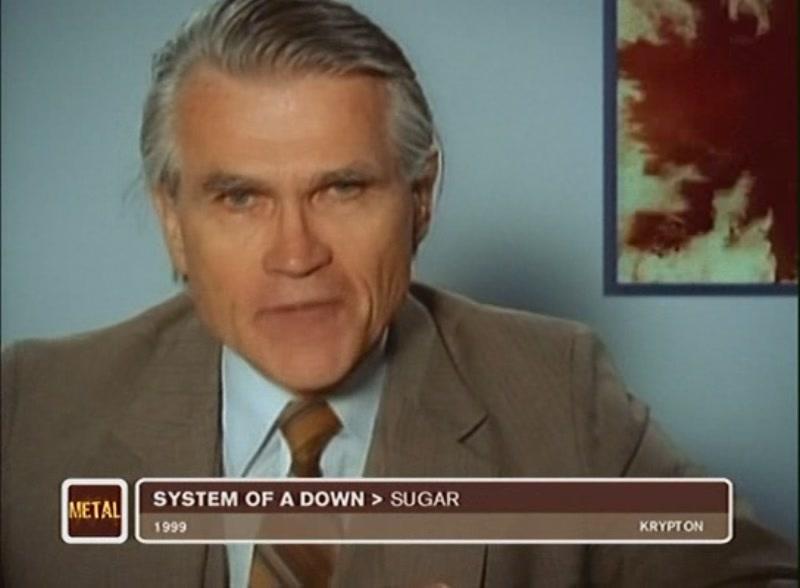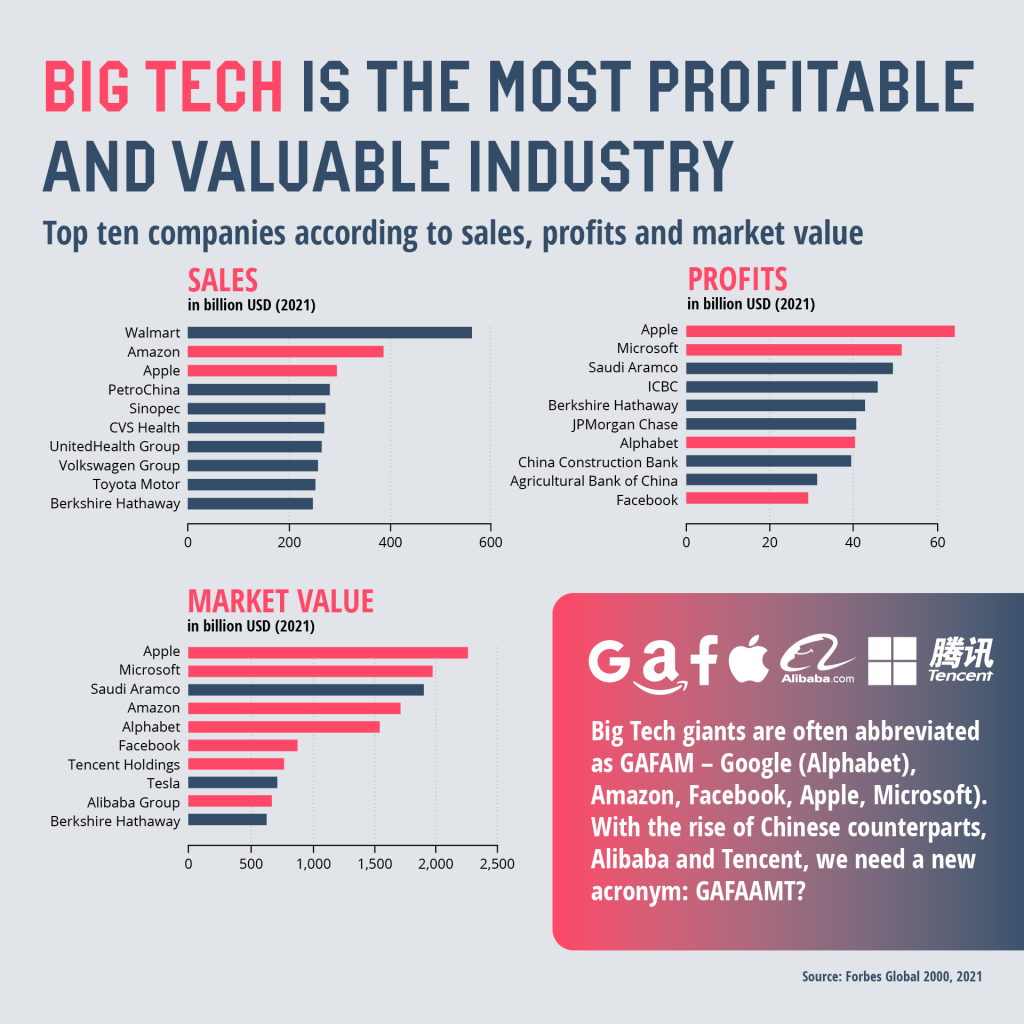This section is (slightly^^) less theoretical and more straigthforward, because it’s an overview of some of the primary actors of modern propaganda and their concrete ideological and strategical intentions. While the theoretical (e.g. causal) relationship(s) between the structural or collective level of systemic ideology/dehumanizations/culture, and individuals’ specific ideological developments and politicizations, is very complex and hard to map succintly, what we can study is what and how relevant sociopolitical actors – states, empires, settlers, the media, etc. – try to use/manipulate information flows for. Below I offer an overview of the various forms of (largely authoritarian/oppressive, reactionary and bourgeois) modern propaganda. Before going into it though, I have a couple more general notes and remarks to add.
Relevant actors in this context include:
- States/govts/empires/settler societies and their various components/institutions/enforcers (e.g. the police, penal and and prison systems, army and intelligence/surveillance services, border enforcement, settlers in occupied lands), as well as international institutions (e.g. IMF, UN)
- Social groups, and usually specific subsets and self-proclaimed representatives thereof
- Media/news/telecom (newspapers, radio and TV broadcasters, online news media, news agencies and wire services) and ICT (social media, search engines, messaging apps) firms/outlets/platforms
- Political/religious/cultural organizations, institutions, groups and movements
- Academia and intelligentsias/ideologues
- The ‘culture industry’
- Capital in general and its own propagandists (on one hand, bourgeois economists/ideologues/sycophants, and on the other, the advertising/commercial manipulation industry)
- Celebrities, social media creators and “influencers”/”micro-celebrities”, scammers, cults, etc.
Each and every one of those obviously have their own social/economic interests and ideologies or political agendas/projects to defend or promote, as well as their own ideological/cultural/sociological characteristics. Indeed, the pretension of objectivity/neutrality of epistemic authorities, mainstream media/journalism, and Hall’s “primary definers”, can never be taken for granted/at their word: because no matter how official, scientifically/academically reputable, or rhetorically/seemingly “unbiased”/”balanced” those actors are, as Howard Zinn would say, “You can’t be neutral on a moving train.”
In science, governance and journalism, the obvious necessity of epistemological/methodological/practical rigor and reflexivity has been wrongly turned into a kind of depoliticised relativism and performative “neutrality”, which are of course both illusory (i.e. neither neutral, nor depoliticised, again because “on a moving train” everyone engages in and with sociopolitical processes/conflicts/etc, whether they know/say/want it or not). And as we already saw, this culture of so-called “objectivity” leads to a “systematically structured over-accessing to the media of those in powerful and privileged institutional positions”, since the latter act as easy-to-reach “primary definers” that the public is supposed to trust blindly (this is of course related to the socio-ideological foundations of the modern bourgeois state, wherein a mythical “general interest” embodied by the state is presumed as freed and separated from society’s conflicts and contradictions).
A lot of these propaganda actors largely prioritize a cynical and shameless defense of their own interests and/or power/position, but this isn’t always nor necessarily the case. Moreover, as we learned from Stuart’s encoding/decoding model, the potential variations of and changing interactions between the four different aspects of media/information processes (capitalist/economic conditions of production, ideological/political framings/bias/messages, relative autonomy of professionals, audience’s own filtering/cognition of info/content) imply that these attempts at defending/promoting certain interests/agendas can take many different shapes/styles/pathways, and are never completely guaranteed to produce the intended outcomes.
Indeed, the forces launching propaganda campaigns don’t always intend to provoke all the effects/consequences that end up occurring, i.e. they can initially aim to nudge things in a certain direction but somewhere along the process this gets disrupted and siphoned somewhere else. Parts of the existing propaganda become indirect byproducts of political or communicative acts by specific actors that weren’t explicitly rooted in a strategic choice to provoke it, but for example re-appropriated by other adjacent forces that re-frame or re-politicize it in a more explicitly propagandistic way, and so on… Hence whereas in many cases assigning responsibility is pretty straightforward – say, Putin, the White House or the IDF/Israeli govt are caught explicitly trying to sway public opinion in other countries – , various other phenomena are harder to pin down directly. Mind you, that doesn’t change the fact that specific sociopolitical forces initially launched some manipulation/disino/propaganda efforts, regardless of the outcome…
What all forms of media – whether traditional or digital/online, whether mainstream or marginal/fringe – share is the potential (and differentiated) ability and power to control what the public can and cannot see, the framings/angles and specific contents/language/rhetoric/implicit messages/ideological assumptions chosen, and therefore what people will know (or not) and how they will interpret it, usually not because they get “brainwashed” into a new opinion/worldview or convinced by specific arguments, but because the slices of information/headlines/stories/etc that they see and focus on will impact their own process of understanding/thematizing/politicizing ongoing events or things.
Hence aside from specific propaganda strategies/campaigns/attacks that deliberately set out to manipulate the media/info/news/social media cycle, the more insidious and arguably more damaging role played by the media and various above-mentioned actors, is contributing to the reproduction of an endlessly destructive cultural and informational environment/ecosystem that feeds on and promotes the most reactionary and dehumanizing currents of modern society. In this sense it cannot be said enough that more often than not, rather than merely the fringe or marginal “extreme” elements (although obviously they play a significant role themselves), it is the mainstream outlets/networks/companies, the gatekeepers, the bystanders, the enablesrs and platformers who do the most damage by promoting dangerous forms of disinformation and propaganda, and especially contributing to the normalization of authoritarian and reactionary rhetoric/framings/lies/arguments.
Sometimes it’s more about carelessness rather than necessarily coming from a deliberate goal of spreading or embolding reactionary elements. For instance, the hosts of the Knowledge Fight podcast, who have been examining Alex Jones’ far right conspiracist show for many years, have repeatedly showed and emphasized that the mainstream and online reporting/reactions/etc about him have always been irresponsible and dangerous. It’s often put the spotlight on some outlandish stunts/clips that more often than not were deliberately planned by Jones to be picked up by the media because of how sensationalist/outrageous they were (e.g. saying he’s ready to “eat his neighbours”). Not only does this have the potential of bringing more reactionary morons to him, because they find him entertaining or share his bigotry; it’s often painted this illusory figure of him as a clownish showman, without ever exposing how his whole worldview and propaganda empire are rooted in a fascist worldview (and it always was).
However, another insight that the case of Alex Jones (both in what he says/does himself, and in the sources/things he uses to do it) highlights is that when it comes to fringe or extreme beliefs/ideas, the quantity of original sources/figures that initiate certain rumors/rhetoric/lies/conspiracist takes/links is often marginal, i.e. although it can take enormous proportions once it’s put online and gets shared ad infinitum, the specific elements that first produce and come up with these kinds of propaganda/disinfo content often represent a very small/restricted group. For instance, in March 2021 the Center for Countering Digital Hate (US/UK) found that “just twelve anti-vaxxers [were] responsible for almost two-thirds of anti‑vaccine content circulating on social media platforms.”
The modern conditions of production and circulation of information/storytelling/reporting are notoriously toxic and destructive to the quality of information, reporting, analysis (although again, let’s not make the mistake of thinking this is an unintended or recent result of tech/Internet/etc having gone mad, rather than the normal functioning of media in capitalist modernity). Like many other industries, ever-increasing productivity/output and ruthless capital accumulation shape the whole media and information ecosystem, which tries by any means necessary to catch people’s attention/eyeballs, their clicks, and so on. For instance, Alec Karakatsanis offers a few notes illustrating this based on his conversations with some TV news employees/producers in the USA:
I was contacted by a lead news anchor for a local television station (…) as well as by several local and national nightly television news producers. I learned a lot from these conversations, but I want to focus on one thing in particular: they face enormous pressure to fill 20-24 minutes of programming several times per day (for each 30 minute local newscast). Depending on the station, this can include a morning news show, a dinner-time news program, and multiple late-evening news shows. It’s not uncommon for even small local tv news to have shows at 6:30am, 6:00pm, and 11:00pm. A mid-market anchor I spoke with works for a station that does several hours of news in the morning, 90 minutes in the evening, and 60 minutes late at night. In speaking with other producers, I learned that it is very common for mid-market news stations to produce even more content than that each day.
And of course, the global media/information ecosystem is in part characterized by extreme concentration, with a mix of global/transnational and local/national/regional firms or groups (and their owners) controlling a significant portion of the world’s media. That doesn’t mean that they single-handedly control all of the information/news; nor that smaller, local/national media outlets or owners aren’t just as engaged in propaganda and disinformation. But it’s still a crucial piece of context, because they hold major influence in setting up some of the framings, agendas, narratives, etc. that prevail.
Unfortunately, as far as I know there aren’t any recent systematic/exhaustive and global studies of media concentration, with clear and reliable data that I could cite here. The most exhaustive international research and data on media concentration and ownership is about a decade old already: a collaborative project started in the late 2000’s that led to the 2016 publication Who Owns the World’s Media? Media Concentration and Ownership around the World (edited by Eli M. Noam). There is a ton of stuff in that book, but I created a general visualization/infographic highlighting some of the most powerful individual capitals:
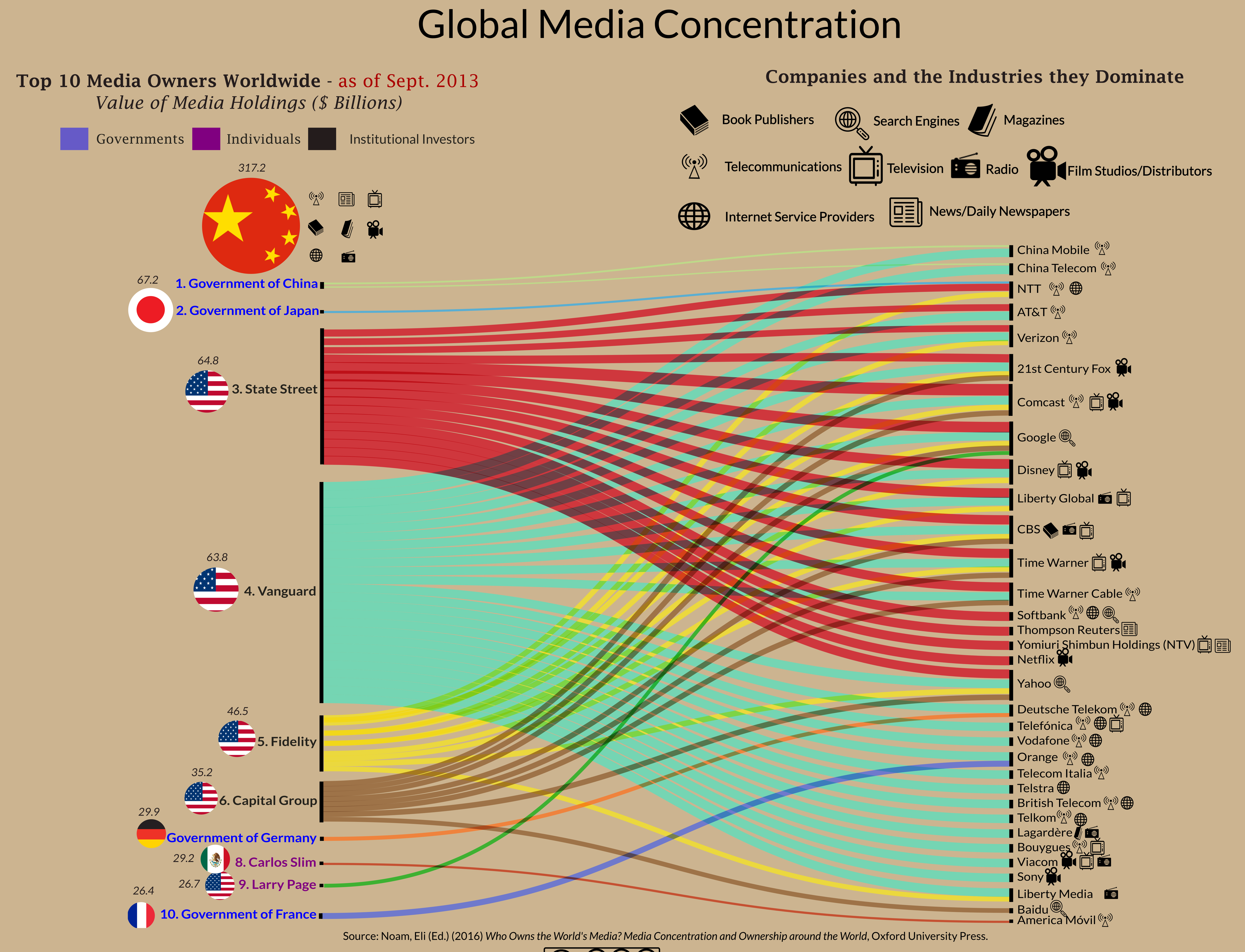
Keeping in mind that this data shows the situation as it was around 2013-2015, I’m gonna use these insights to outline some general characteristics of this capitaliste sphere; later I’ll also adress how the media, state/govt, suverillance and policing, military, and big tech are all deeply intertwined). Most of the powerful actors and capitalists from a decade ago that I’m mentioning here are still dominant today, despite some switches of ownership, and a few newcomers (e.g. Netflix and TikTok).
Some of the largest owners of media companies/networks/service providers are governments, that either invest in private companies and/or directly produce media via public or state-controlled companies. Based on the 2016 book/data, the Chinese government was by far the biggest individual capitalist in terms of economic power in the global media landscape, across nearly all forms of media (book publishing, telecoms, radio, television, films, news and daily newspapers, internet services…), with for instance state-owned companies like China Mobile and China Telecom. Other major state actors owning and/or producing major media outlets/services included the governments of Japan (NTT), Germany (Deutsche Telekom), France (Orange) and Norway (through its oil-based wealth fund, which invests in tons of stuff internationally). I said “owning” but in many cases these companies where technically privatized, generally having been originally created as a state monopoly; nonetheless (and here you can see how state and capital overlap beyond misleading “private vs public” distinctions) they often remained the biggest owners/shareholders afterwards.
There were also a few dozens of individual or family-based capitalists, including Mexican magnate Carlos Slim (who owns the telecoms firm América Móvil), Mark Zuckerberg, Google’s Larry Page/Sergey Brin/Eric Schmidt, and the Cox (cable and telecoms provider Cox Communications, USA), Thompson (global news agency Reuters, Canada), Marinho (media conglomerate Grupo Globo, Brazil), Roberts (media conglomerate Comcast, USA), Murdoch (News Corp, and 21st Century Fox until 2019). Around 2013 the notorious and infamous Murdoch family and group weren’t in the top 10 in terms of total media holdings (which was mostly made of states/govts and institutional owners, as you can see), but ranked among the top for market shares for television channel companies, TV broadcasters, online news companies, film studio/distributors (via 21st Century Fox), magazine and book (via Harper Collins) publishers, and noticeably, daily newspaper companies (via News Corp) with an insane 7.9% market share of world industry total (#1 in the world).
As the example of The Walt Disney Company’s 2019 acquisition of 21st Century Fox shows, huge media companies themselves tend to eat up the market and accumulate/concentrate media holdings. Today media and Big Tech are fundamentally intertwined because of the Internet, and not only did Big Tech giants – Alphabet/Google, Meta Platforms/Facebook, Apple, Amazon, Microsoft and Chinese conglomerates like Alibaba and Tencent Holdings – gain this hegemony by cannibalizing the whole tech sector (i.e. “gobbling up small tech”), they’re the most profitable and valuable capitalist industry.
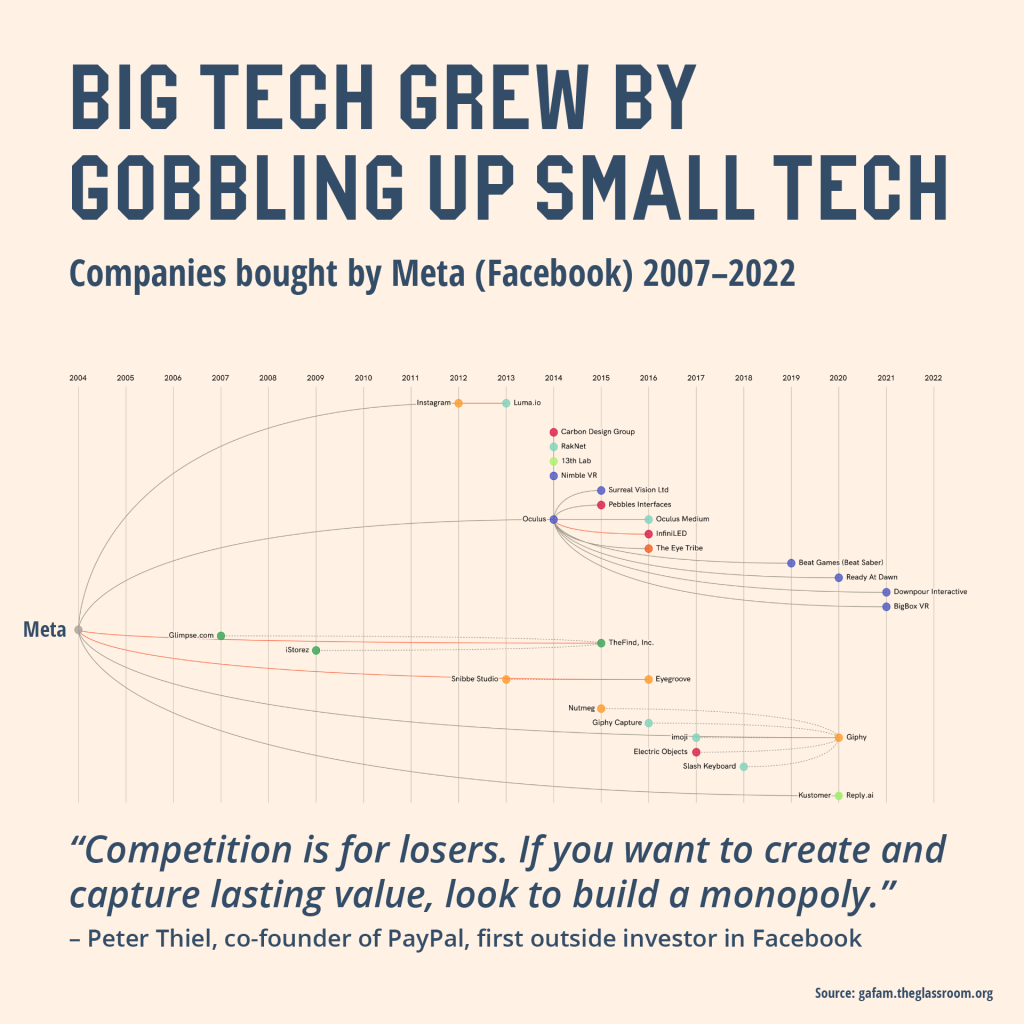
Source: “Big Tech – The rise of GAFAAMT” by the Transnational Institue, State of Power 2023: Digital Power.
So-called “institutional owners” – companies collecting enormous capital and specialized investment/financial services – are another type of hugely powerful capital in media industries, which is perhaps the most striking insight of the alluvial diagram in my infographic (for the 2013-2015 period). Put together, State Street, the Vanguard Group, Fidelity, Blackrock and the Capital Group were large/significant owners and/or investors in almost all of the world’s biggest media companies. While it’s almost certainly still the case today, we do know that they’re also by far the biggest owners of Big Tech:
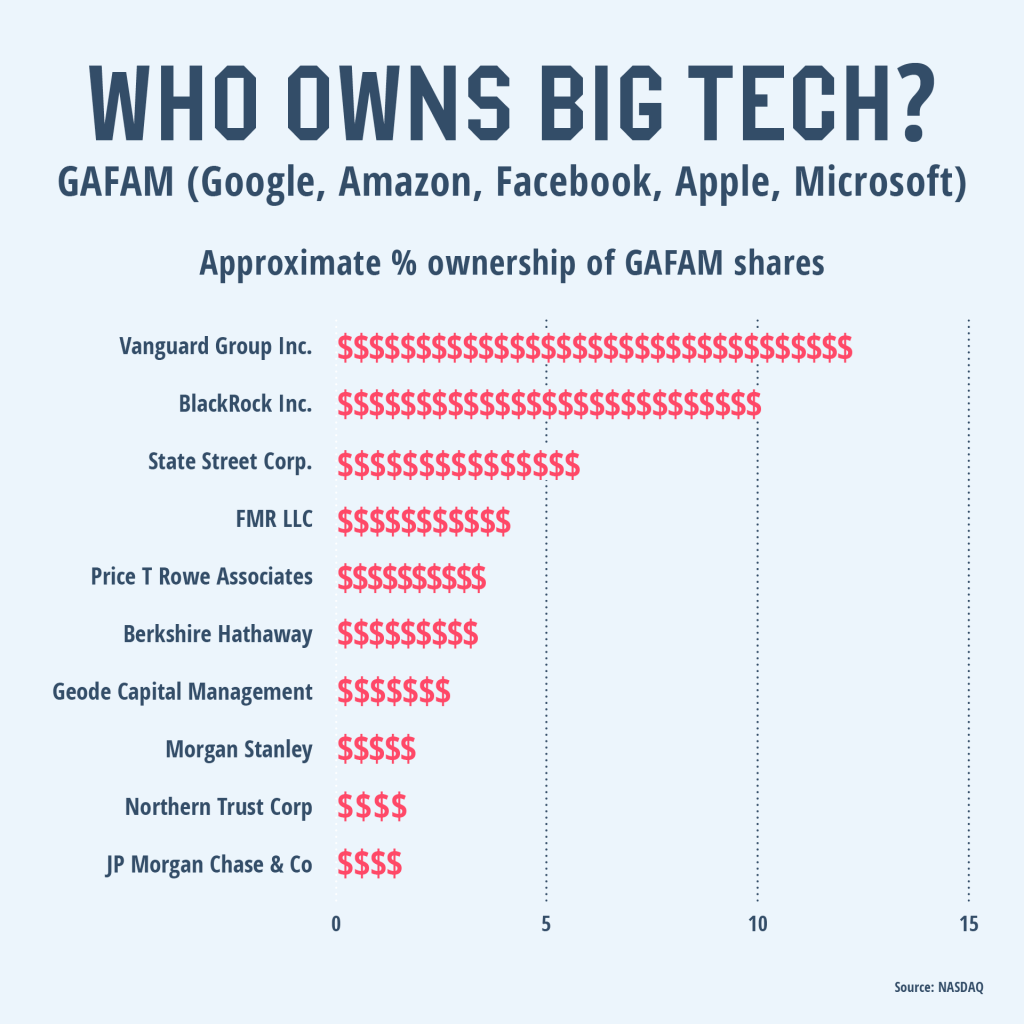
Big Tech dominate global cloud computing, browsers, mobile operating systems (because “most devices run on the proprietary Android version developed by Google, which ship with additional proprietary closed-source software pre-installed most notably Google Mobile Services”, and when they don’t it’s usually other Big Tech that benefit/fill the gap, e.g. Amazon, Alibaba, etc)
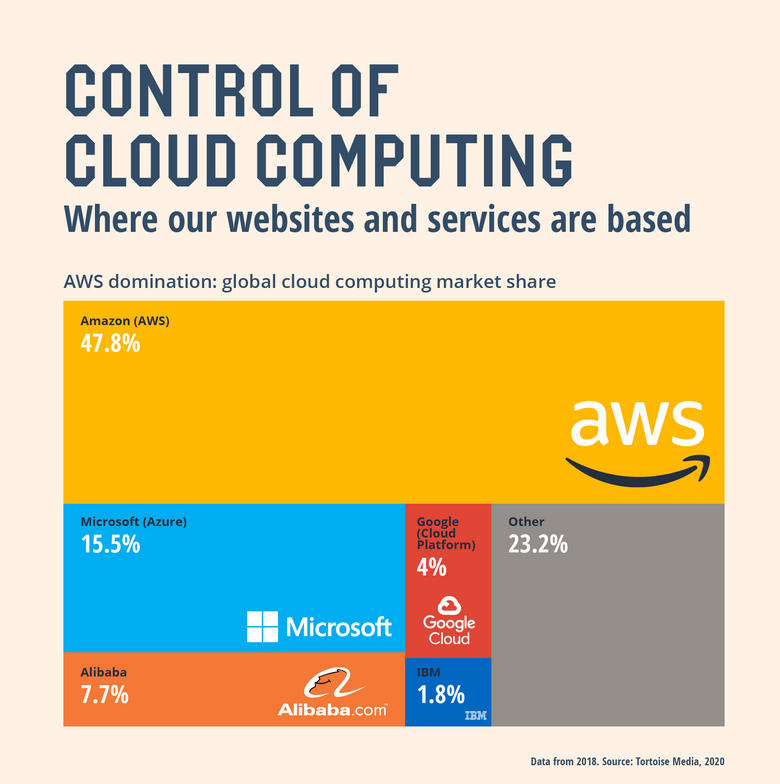
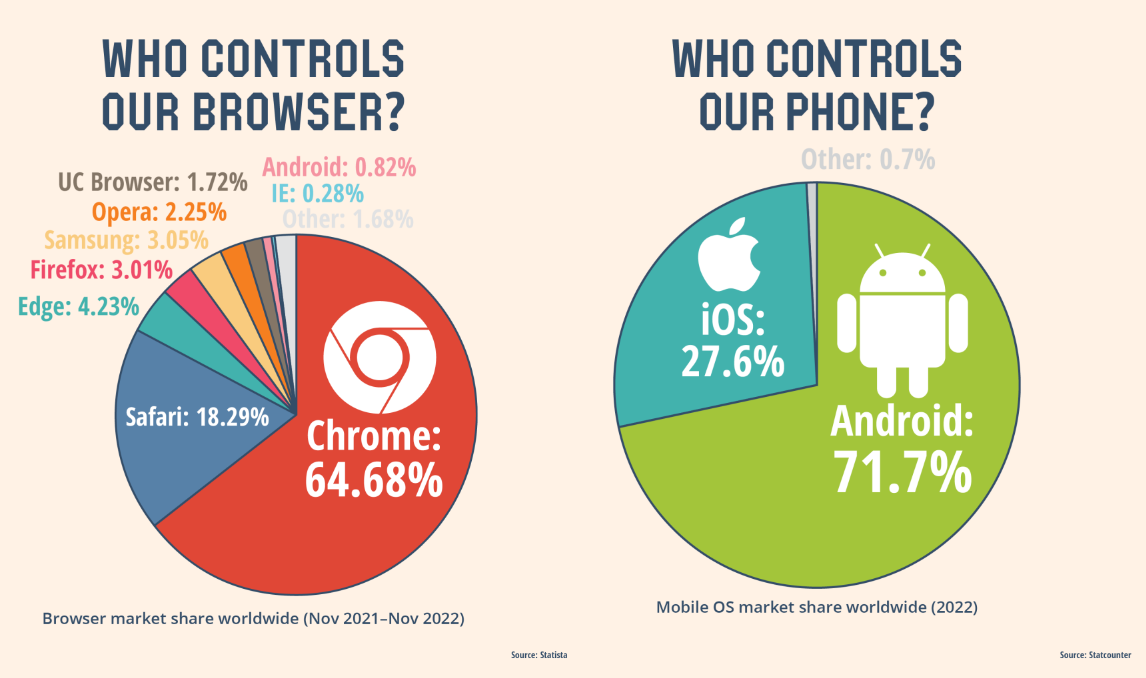
In the past decade, they’ve also massively increased their share of internet cable usage and submarine cables:
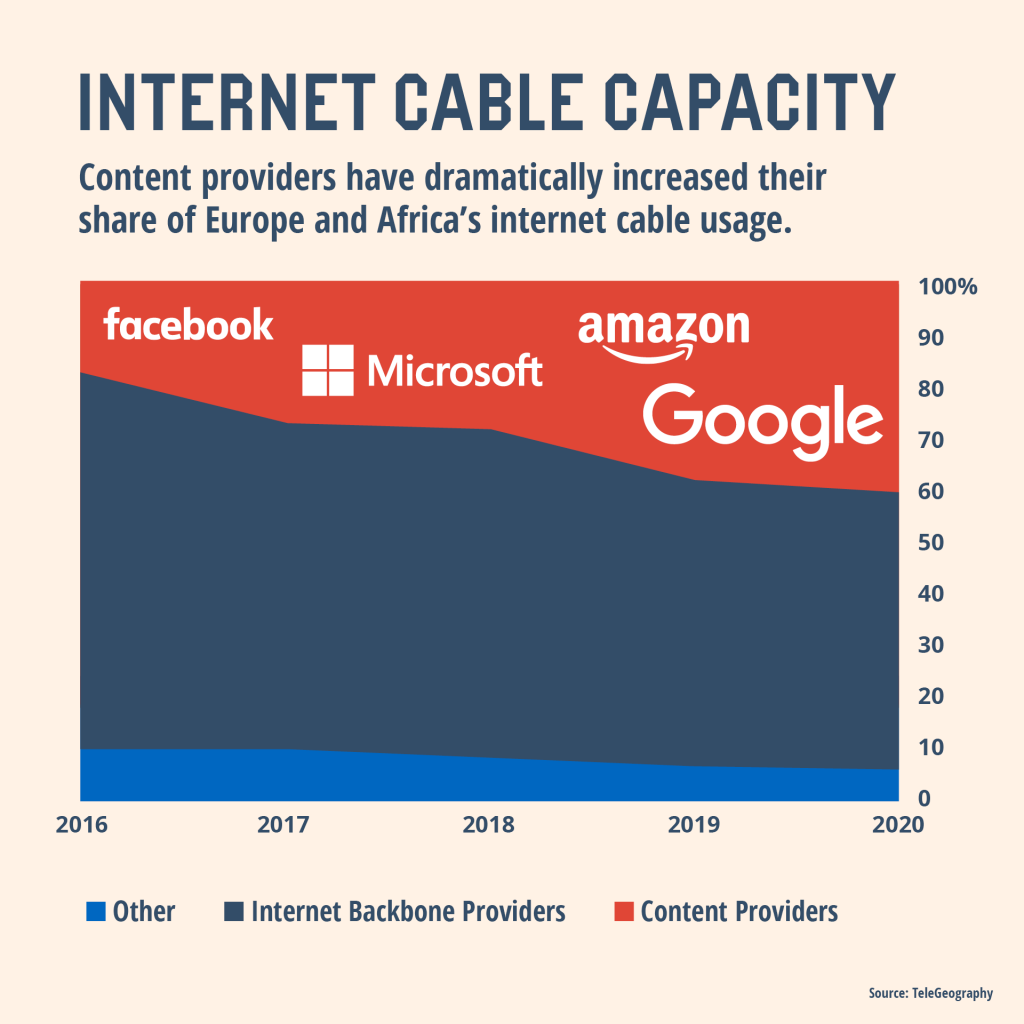
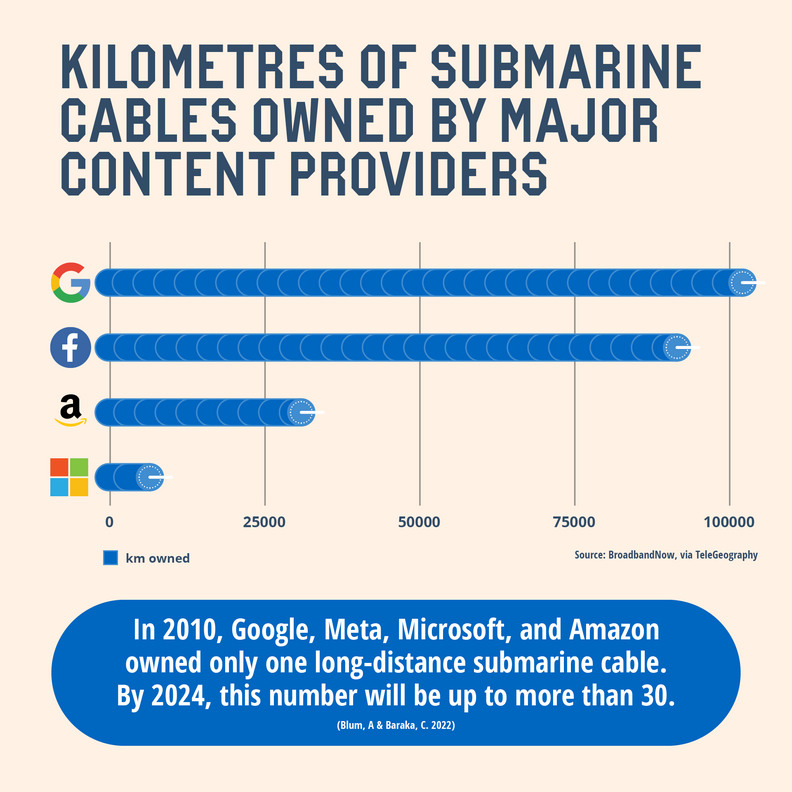
They’re also some of the biggest corporate lobbyists in both the USA and Europe:
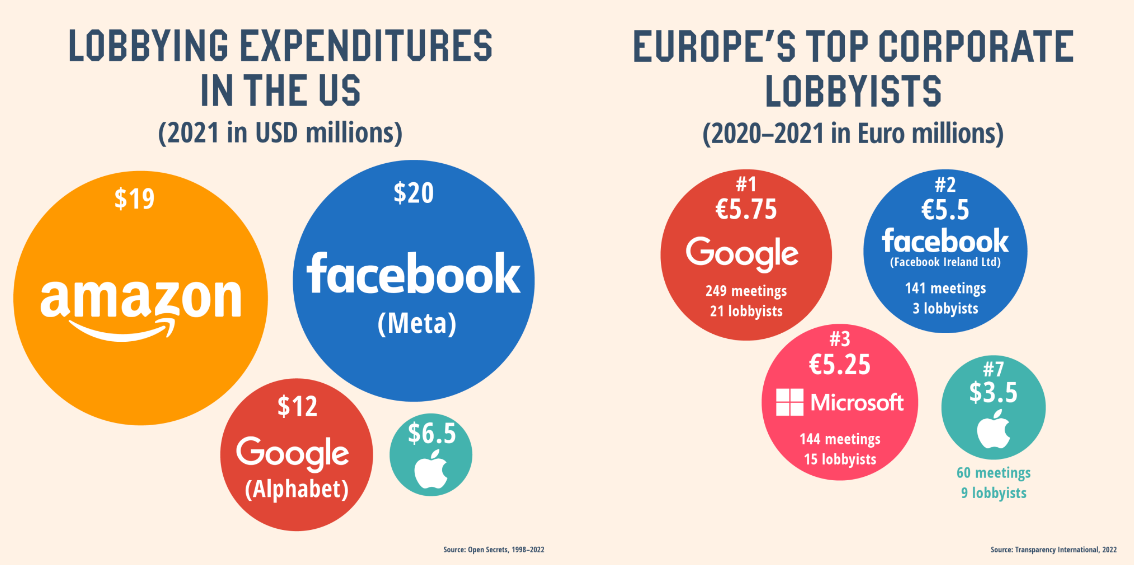
As the Transnational Institute conclude:
The result is a digital world in which a few companies secure extraordinary profits, workers and suppliers are squeezed, and a business model of surveillance is normalised.
This is why some authors have expanded the classic notion of ‘military industrial complex” to include both the media and digital technology (“Media-Technology-Military Industrial Complex” is not useful phrase, but you get the idea). Again, this dynamic has expanded rapidly in the past decade:
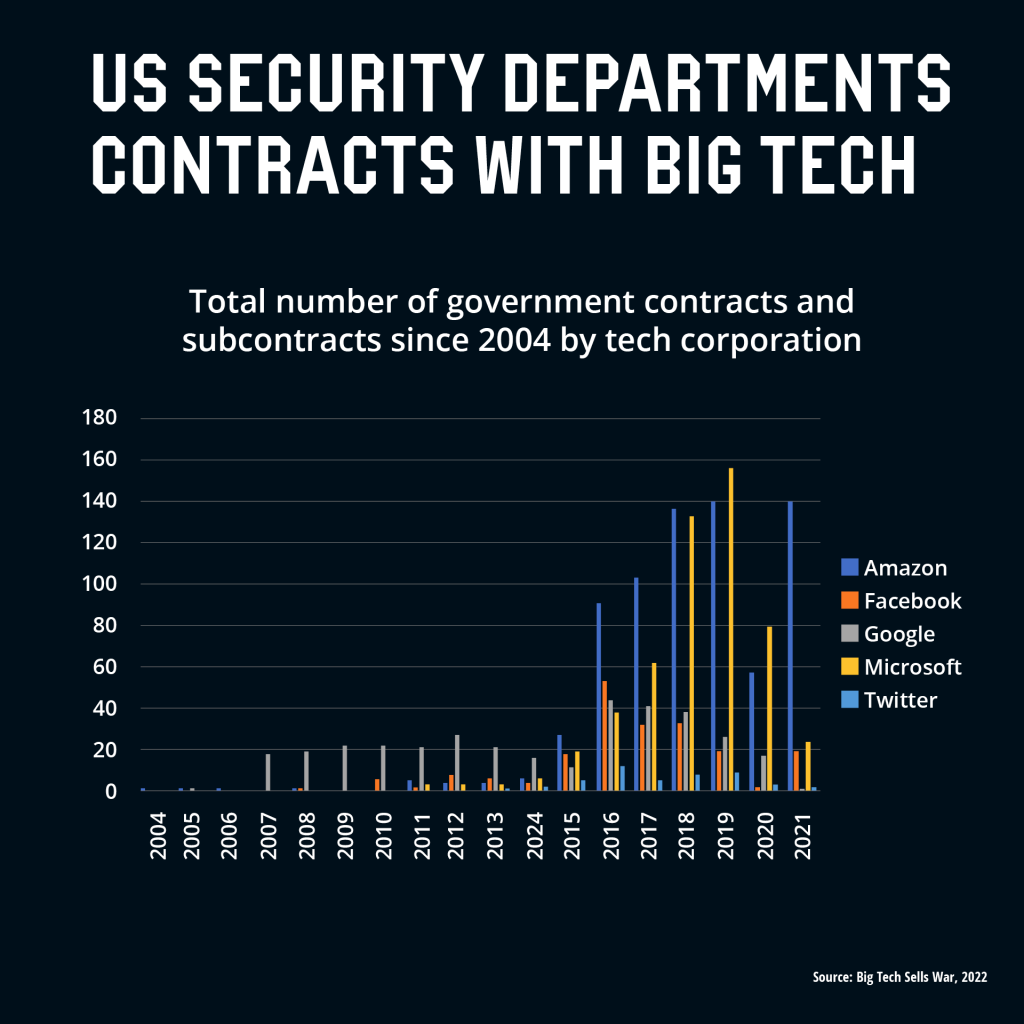
I’ll leave the economic/media concentration issue here for now, but it’s a fundamental dimension of today’s global media/information ecosystem. Let me just add that another relevant aspect concerning the conditions of production/circulation of media/information is the reliance on news agencies/wire services (e.g. Agence France-Presse, Associated Press, Reuters…), which has kept expanding since the telegram was invented/introduced. This goes back once again to Stuart Hall’s observation about primary definers, wherein the restless and mindless 24/7 news cycle (and its productivist logic/incentives) as well as the already-mentioned performativity/ideology of so-called “objectivity”, make media/information producers constantly rely on easy-to-reach sources who have a level of respectability/authority, which is what news wires provide but they themselves clearly rely on the same acritical information gathering. For instance, the endless and usually uncritical repetition and diffusion of statements by states/govts and official authorities, warring parties, international institutions and norms, lawyers, representatives and spokespersons of certain “interest groups”, is tied to this informational and economic logic. Stats, capital and other political forces all know that, so they’re able to use strategies to control some of the filters, framings, definitions, and angles used in these widely-diffused news stories that media profesionnals the world over rely on and repeat.
Next, I will go through a selection of major forms of modern propaganda, explaining what they consist in and giving examples and more notes.
